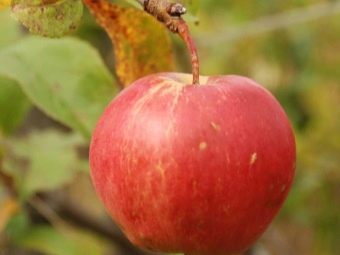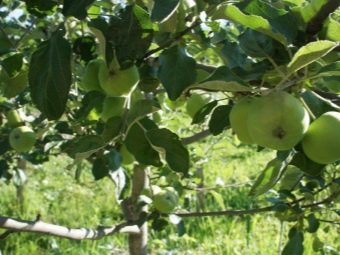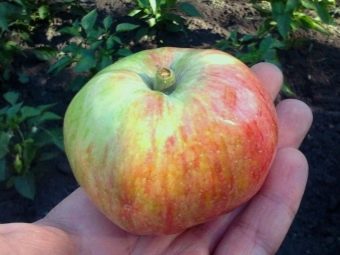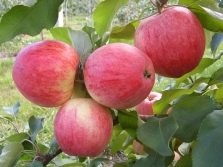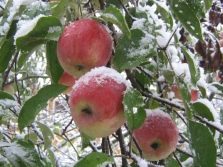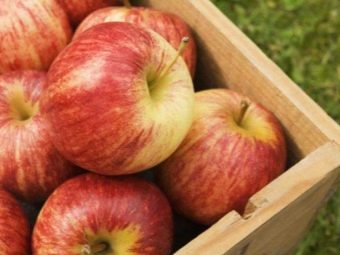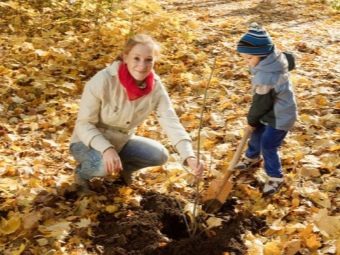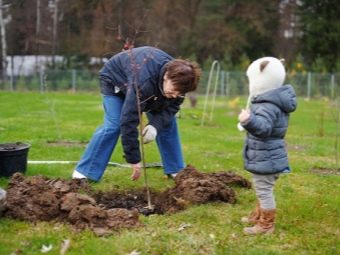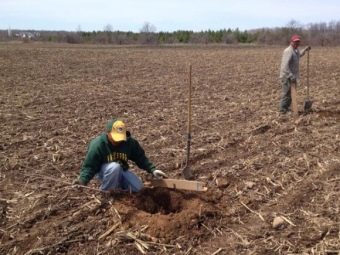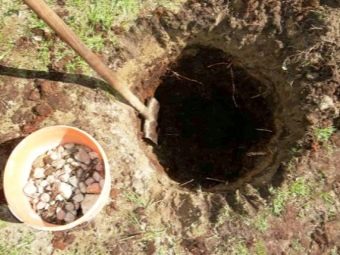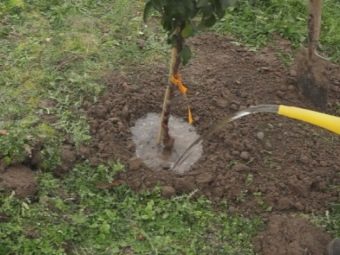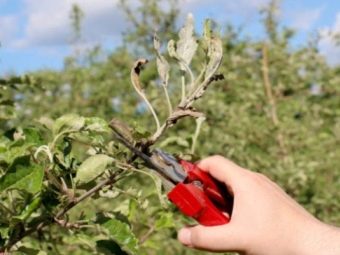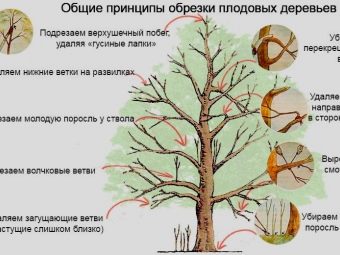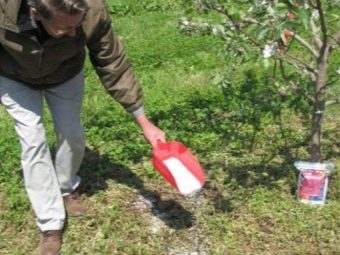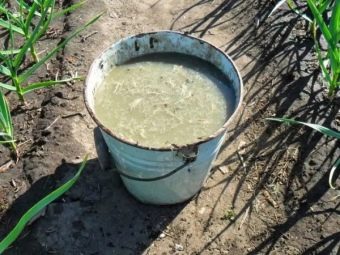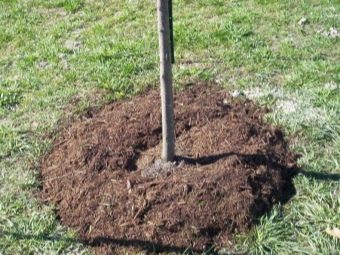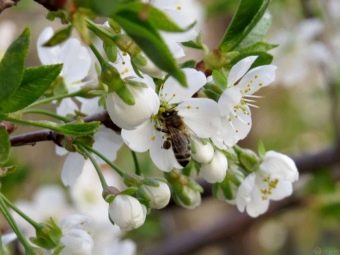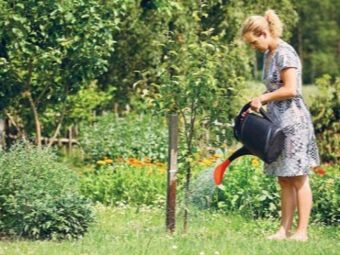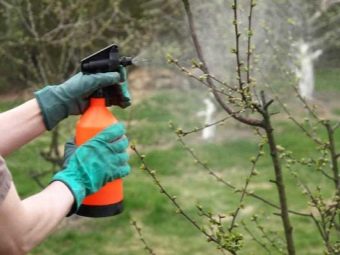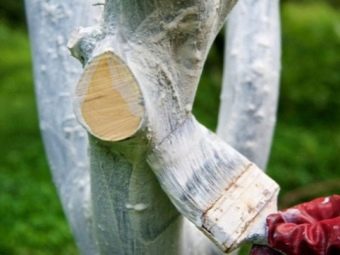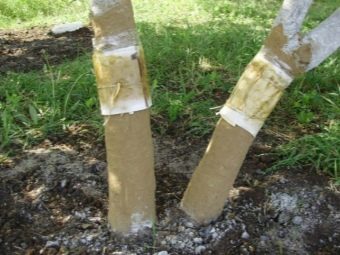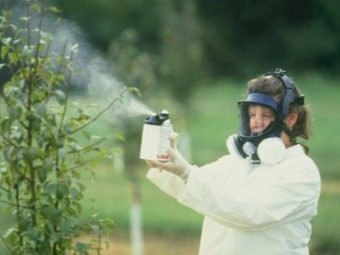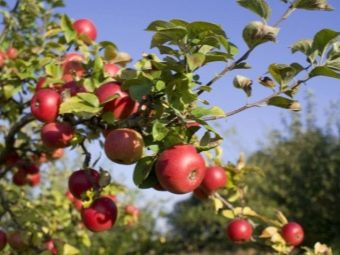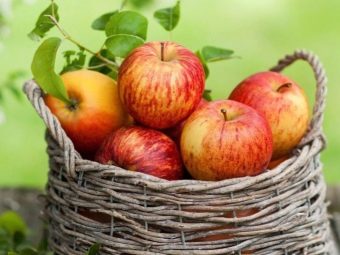Apple tree "Medunitsa": description of the variety, planting and care

Apple tree is considered one of the most beloved fruit trees of every gardener, as it is easy to maintain and allows you to collect a good harvest at the end of the season. Since the apple tree is represented by many species, it is very difficult to make the right choice in favor of one or another variety, especially if the land area is limited and there is no possibility to check the variety in practice.
Today, the variety “Medunitsa” is very popular among summer residents, it is ideal for growing in various climatic zones and is characterized not only by tasty fruits, but also by excellent resistance to fungal diseases.
Variety description
The apple tree "Medunitsa" appeared in the gardens thanks to the biologist Isaev S. And, who brought it in the 30s of the last century. It, like any other tree species, is characterized by its individual features, and also has advantages and disadvantages. The height of the tree is considerable, and with proper care it can reach 7 m. The plant is characterized by a sparse, wide pyramidal crown with a large number of sheets. Yablon is characterized by secondary shoot formation, therefore, for its normal development and the active formation of fruits, special pruning technology is required.
The shoots of the tree have a light green color, they grow rounded or oblong leaves with subtle plates. Fruits of this variety are small, with a regular round shape, their average weight is up to 150 g. Honey apples at the beginning of ripening become yellowish-green in color, they may contain pronounced red or orange stripes. Then they turn completely red with a big blush.
The main advantage of "Medunitsa" is its taste. It is sweet, because one apple can contain up to 14% sugar. The flesh of apples is juicy, slightly dense, with a light honey aroma. The tree can bear fruit up to 50 years and the first crop gives already in the 6th year after planting. To get a high yield all the time, you need to regularly carry out normalization of the ovary. Apples of this variety are characteristic of both dessert and table purpose, they are ideal for preparing juices, jams and jams.
"Medunitsa" is of several types.
- Summer. It is a tall plant with a sprawling crown, on which are formed yellowish-green apples with a crimson blush on the sides. Apples are well stored, from one tree in late August or early September, you can collect up to 80 kg of tasty fruits. They differ juicy pulp with a characteristic cream shade.
- Winter This variety is selected on the basis of summer, but the winter apple tree differs from the “mother” variety only in terms of ripening, it begins to bear fruit from the end of September, its apples are also sweet with a honey flavor.
- Dwarf. This apple has a height of not more than 2.5 m, which simplifies cleaning. The tree brings the first fruits already in the third year after transplantation, they appear in the middle of July.
“Medunitsa” is referred to as self-bearing species, but for greater efficiency in fruiting, experts recommend planting “companions” with the same flowering period next to it, but the period of their maturation may not coincide.
For pollinating a tree, varieties such as Victory and Anis are well suited. The flowering period in apple trees is observed from May to June and depends on climatic regions.
Apples are recommended to be harvested until full maturity, since, unlike ripe ones, they are stored much longer, up to 4 months. Fully ripened fruits can lie no more than one month. In addition, one very interesting peculiarity is peculiar to Medunitsa: its fruits can change their taste over time. Saturated honey aroma is present in apples only the first two weeks after picking them from the tree, then disappears.
This variety is frost resistant, it makes it popular and valuable.The trees are well tolerated by the first frost and do not die from extreme cold, therefore, apple trees can be successfully grown even in Siberia or in the Urals. Compared with other types of apple trees, Medunitsa is resistant to fungal infections, due to its high immunity, it rarely suffers from scab. But since recently, new diseases often appear, for prevention, the tree should be treated with special preparations.
Despite all the advantages of the variety, he has some minuses:
- The apple tree is demanding for pruning, which must be done regularly;
- the harvest of adult trees depends on rationing;
- short shelf life of fruits;
- apples ripen non-simultaneous, which complicates their assembly;
- loss of honey taste during storage.
Planting seedlings
The most crucial moment for each gardener is planting seedlings. It must be carried out correctly, given the climatic zone where the land is located. Most often for the works pick up the end of the fall or spring without spring. So, for example, in the middle and central zone of the country, “Medunitsa” is recommended to be planted in the autumn, and in the Urals and in Siberia - in early spring, as this allows the trees to settle down faster and become strengthened before the onset of frost. In addition, if the regions have little snow, the trees should also be planted in spring. Before the start of garden work, the soil should be thawed and easy to dig to a depth of 60 cm.
Forming a garden, we must not forget that the plant will grow large and branched, each year it will increase in size and will require a lot of space. Therefore, to make trees feel comfortable, between rows it is necessary to leave a minimum distance of 5 m, and between the plantings themselves not less than 4.5 m. Planting material should be chosen, taking into account its size, the duration of fruiting and the ripening of apples. When there is not enough space on the land plot, then the right choice would be to buy Medunitsa dwarf or columnar varieties, they are compact, their height does not exceed 2 meters.
Apple trees are planted in a certain way.
- First preparing the seat. If the landing is planned for spring, then the hole should be dug until the fall, while landing in the fall - on the contrary, in spring or summer. The territory for the garden, it is desirable to choose in an open and well-lit area. It must be far from buildings and protected from the wind. In the case when the soil is clayey, it is necessary to lay a drainage system. A huge role is played by the level of passage of groundwater.
- After the place is chosen, digging is dug, the size of which must correspond to the root system of the tree. Typically, a two-year planting material digs a recess 50 × 50 × 50 cm. Dug land should be divided into fertile and the rest. Then mineral components are added to the fertile part, and it is half-filled by the pit. Apple trees should not be planted immediately, you have to wait a bit until the soil settles and is filled with oxygen.
- In the central part of the recess, a wooden stake is driven in and a sapling is placed, its roots gently spread and covered with soil. The root neck of the seedling should be 10 cm from the ground level. The ground near the trunk is slightly compacted, and the tree is watered abundantly, re-adding a small layer of soil.
Usually 2-3 buckets of water are spent on one tree.
Care
It is not difficult to grow Medunitsa, but, like any other variety, it must be provided with proper care, the main one considered to be top dressing, good watering, pruning and protection from diseases. As a rule, during the first year after disembarking, the apple tree does not need thorough care, it is enough to only water it, most of the activities take place next season. At first, watering is performed, taking into account the degree of drying of the upper soil layers. The procedure is repeated every week.
After the first successful winter, the apple trees are pruned in the spring, since the formation of its crown is activated in the second year of life. Pruning should be done in such a way that the tiers are placed in parallel, and the distance between them is no more than 40 cm. Thanks to this normalization, the plant will be able to maintain its characteristic shape in the form of a pyramid. In addition, some gardeners prefer the shape of the crown in the shape of a bowl, for this the central shoot is pruned, and 4-5 side branches are left.
"Medunitsa" refers to vigorous varieties, but its shoots are formed slowly, therefore, if the pruning schemes are not fulfilled, the tree will slow down its development and reduce the yield. To prevent this, you need to consider the following rules:
- sanitary pruning in spring and autumn is important for apple trees, during which diseased and damaged branches are removed;
- annual pruning is obligatory, in which the crown is barely exposed and the growth of new branches is activated;
- In the summer, the apple tree should be nipped by clearing large branches that replace the fruit.
Special attention should be paid to the nutrition of the root system of the apple tree. Typically, feeding is carried out in spring and autumn. In the first case, it allows you to stimulate the growth of foliage, and in the second it improves the formation of fruits. At the same time, autumn dressing helps to strengthen the wood and its subsequent preparation for wintering. At this time, the apple tree should be fed with potassium and phosphorus, strictly observing the dosage.
In the spring, a mixture consisting of water and urea is poured under the root. In the summer, it is replaced with sodium humate, and in the fall it prepares top-dressing from superphosphate. It is worth paying attention to the fact that mineral components are brought to a small depth in the area of location of the trunk circle. Manure or chicken manure can also be used to stimulate growth. After each feeding the apple should be watered abundantly.
At the end of autumn, the foliage and other plant residues must be removed from the seat and the soil should be dug up, protecting the weak trunk from severe frosts. Newly planted apple trees are best wrapped with spruce branches, since their trunk cannot be whitened. Adult plantings are whitened in autumn and spring. Such activities will help protect the trees from the cold and carry out prevention from pests and diseases. Additionally, "Medunitsa" can also be sprayed with special solutions, which include copper.
Before the onset of the first frost, the tree needs careful preparation. For this place around his trunk is laid with humus or peat. Also in winter you need to rake up snow to the trunk, forming a mound that will protect the seedling from the cold.
When an apple tree blossoms, additional pollinators are needed for it. In order to create all the conditions for pollination and increase the yield of the variety, solutions attracting bees are suspended on the branches. They are prepared on the basis of sugar and honey. Also in the dense crown of an apple tree, you can place containers with water and put branches in them with flowers of other summer trees.
As for watering, the "Medunitsa" is not too demanding on him. This is explained by the fact that the roots of the tree are able to independently extract moisture from the ground. If summer is hot and dry, then you need to water the apple tree. To do this, regularly make 5 buckets of water for one pleasure. In this case, together with water it is recommended to make additional feeding.
Watering must be controlled, as excessive moisture can damage the plant, causing root rot and loss of taste of the fruit.
Diseases and pests
"Medunitsa" was selected by a special method, so it is famous for its high resistance to most pests and fungal diseases. If during the cultivation of an apple unfavorable conditions are created, then it can still "get sick." Therefore, for the prevention of trees is recommended to handle protective agents.Spraying in spring and autumn is considered important, which reduces the probability of the disease and reduces the population of pests for the next season. In addition, the garden should be well cleaned from weeds.
Spring sanitization consists of several stages, since it depends on many factors. For example, during the blooming of buds, an apple tree cannot be sprayed, it can disrupt the formation of the ovary and the pollination process. In addition, the protective measures are chosen, given the type of insects that breed in different ways and hit the tree. Initially, the apple tree is treated in March, since during this period the buds are not yet formed and there is no sap flow. It is sprayed with chemical solutions, lime is whitewashed, and the trunk is cleaned from lichens and dry bark.
Then work is carried out in April after the buds appeared, but did not begin flowering. At this time, to protect against the flowering tsvetoueda apple put trap belts and spray branches with biological preparations. When the trees are in bloom, indirect measures are taken to control the bugs, which consist of manually assembling insects and removing weeds. The use of chemical solutions during the flowering period is prohibited, because they will harm pollinators. At the end of flowering, the apple trees are treated with special preparations against the defeat of the fruit and foliage by the pinwort or leafworm.
Before spraying the trees, it is important to choose the right pest control products. According to the method of exposure, they are divided into systemic and contact. At the same time, the latter are considered more effective, since they directly fall on the pest, block its activity and after a week easily wash off with rain and do not harm the plant. Such tools are well suited for spring work, striking insects that remained on the apple after wintering.
System tools guarantee protection for two weeks and are used, as a rule, at the end of spring. Such drugs penetrate into the plant and spread through all its channels, poisoning the pest's digestive system. To prevent stem rot and scab of an apple tree, it is necessary to spray it with a solution of saltpeter or Bordeaux liquids, and in autumn to whiten the stem with slaked lime. This procedure will protect the tree not only from diseases, but also small insects.
From the rodents in the winter, trees are covered with spruce leaves or wrapped with shingles; sacking or matting is well suited for this.
Gardeners reviews
Variety "Medunitsa" is in great demand among summer residents, as it does not require special care. The most important thing is to properly trim the tree and water it well. Apple tree also received positive feedback due to its fruits with exquisite taste and unusual honey aroma. It is famous for its excellent fruiting, with proper care at the end of the summer, you can harvest a high yield of sweet apples, which are excellent for both preparing juices, jams, jams, and fresh.
The only drawback of apples is that they lie for no more than a month, if they are gathered in a mature form. But despite this, experienced gardeners recommend it for cultivation, since, with minimal effort, at the end of the season you can please the family with a healthy and fragrant fruit.
See how to look after an apple tree in the next video.


